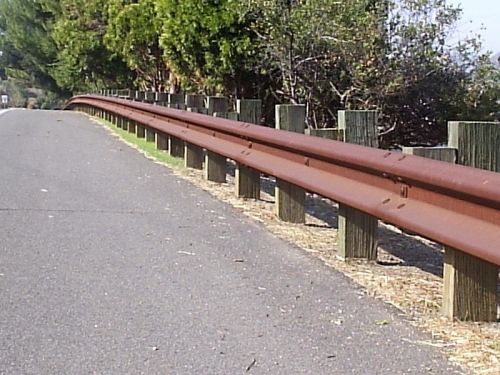

- Bridge guard rails install#
- Bridge guard rails driver#
- Bridge guard rails full#
- Bridge guard rails free#
The LON is the length of barrier required to adequately shield the object or area of concern and prevent a vehicle from reaching the shielded feature. See the HKP article, Roadside Safety (coming soon), for a discussion of barrier warrants.
Bridge guard rails install#
2.4 Temporary Guardrail InstallationsĬontractors that install a temporary guardrail during construction must comply with construction requirements for permanent guardrail. The Division a project originates in - Division of Highway Design or Division of Maintenance - is responsible for reviewing and approving the use of alternative guardrail systems. Use of an alternative guardrail system requires written justification. If an alternative guardrail is utilized, it should be appropriate for the road context. Examples of alternative guardrail systems include the weak post W-beam, Weathering Steel Guardrail, and Steel Backed Timber Guardrail. Other approved guardrail types may be used on Kentucky highways. 2.3 Alternative Guardrail Systems (Non-standard in Kentucky)

KYTC maintenance crews will continue to maintain strong-post W-beam guardrail systems until they reach the end of their service lives. Raising all existing guardrail systems to meet current criteria is neither cost-effective nor practical. Many of these systems have and should continue to have acceptable real-world performance. Strong-post W-beam guardrail systems have been installed at different heights, ranging between 27 to 29 inches.Īlthough the Cabinet has adopted MGS for all new installations, many miles of strong-post W-beam barrier have been installed based on previous NCHRP 350 guidance. The strong-post W-beam meets NCHRP 350 Test Level 3 criteria and was mainly used before the adoption of MASH testing criteria. Blockouts are typically made of timber or composite plastic and are 6 or 8 inches deep and 6 inches wide. It consists of wood or steel posts that support a W-beam rail element blocked out from the posts. Prior to 2018 the standard guardrail in Kentucky was the strong-post W-beam. O MGS relocates the splice (weakest link) away from the highest stress point at the post and blockout.įor MGS installations, contractors must use W-beam panels that are 12 feet 6 inches or 25 feet in length, but they may employ a 6-foot 3-inch panel at the end of the run. 6 inch x 8 inch routed or non-routed wood or composite plastic offset blocks.O Longer posts may be used (e.g., 7 feet or 9 feet) (see Section 5.1, Strengthening Guardrail). Minimum 6-foot-long W6 x 9 steel posts or 6-inch x 8-inch wood posts.31-inch top of rail mounting height and tolerance of +/- 1 inch ( see Section 3.5, Guardrail Height).The system adopts a typical W-beam guardrail with the following characteristics: MGS is a non-proprietary steel or wood post W-beam guardrail system that meets MASH Test Level 3 criteria. KYTC currently uses Midwest Guardrail System (MGS) for new installations of standard guardrail and corresponding end treatments. In addition, it discusses selection procedures, maintenance of operational systems, and guidelines for upgrades. This article describes design, construction, and maintenance practices related to guardrail.

Bridge guard rails full#
Where it is not practical to provide a full clear zone, the use of guardrail or another roadside barrier offers an attractive option as it significantly increases the safety of vehicles departing the roadway. Always consider alternatives to guardrail installation before deciding to install guardrail (e.g., removal or relocation of the obstacles). The only circumstance under which a guardrail should be installed is if it presents a lower risk to vehicles than unshielded roadside obstacles.
Bridge guard rails free#
A road engineer’s primary goal is to provide an adequate clear zone free of any obstacles and areas of concern. Guardrail does not eliminate the possibility of injuries or fatalities.
Bridge guard rails driver#
When a vehicle impacts a guardrail, its driver and passengers encounter some risk. In some cases, guardrail is installed for reasons other than to safeguard motorists against obstacles (e.g., road closure barricades and barriers protecting pedestrians or sensitive areas). Guardrail prevents vehicles from descending a steep roadside embankment or veering into the roadway median and oncoming traffic. By redirecting a vehicle departing the roadway, a guardrail keeps it away from more serious hazards, both constructed (e.g., sign structures, culvert inlets, utility poles) and natural (e.g., trees, rock outcrop). A guardrail is a longitudinal, roadside barrier system that is installed to prevent errant vehicles from impacting roadside obstacles.


 0 kommentar(er)
0 kommentar(er)
